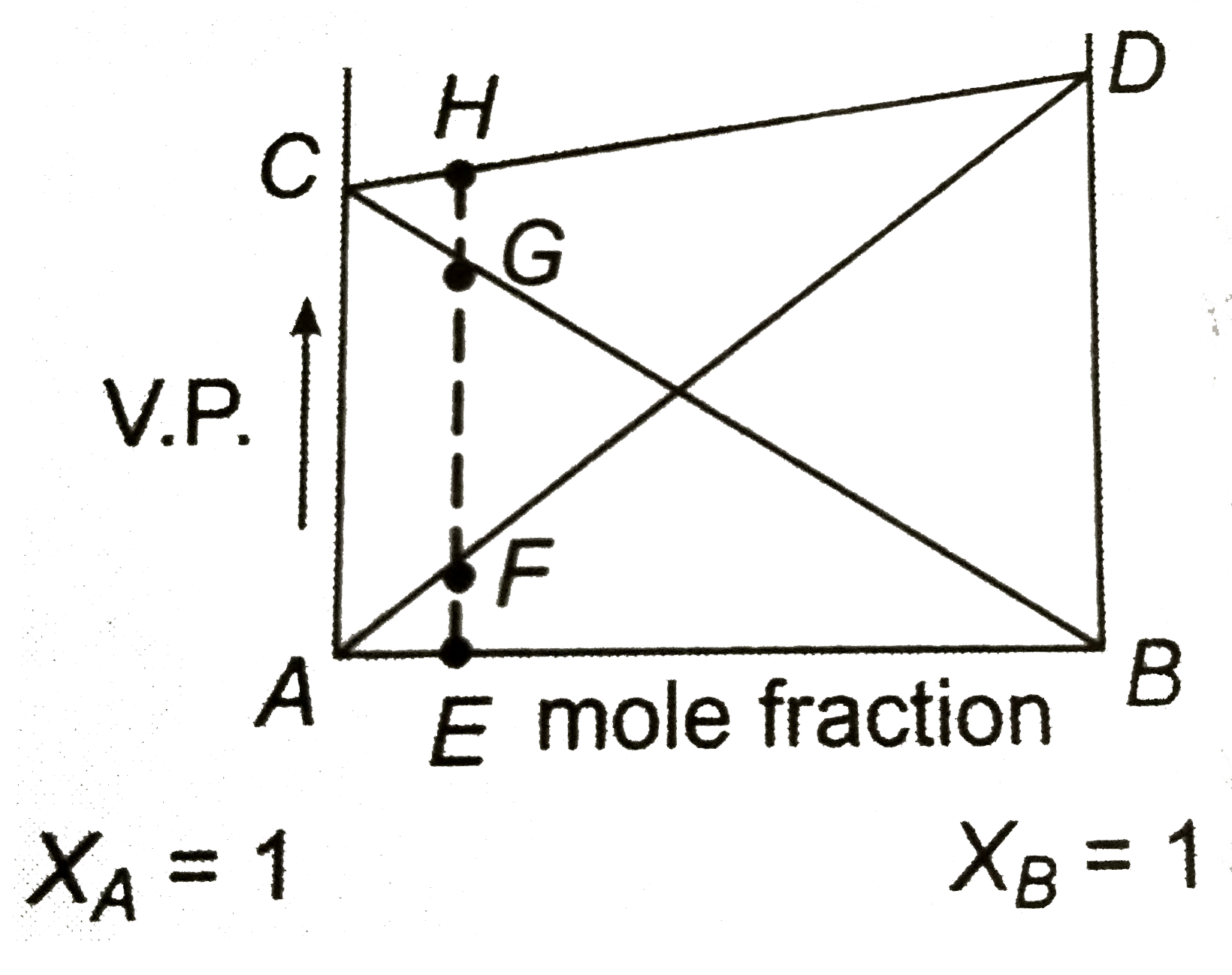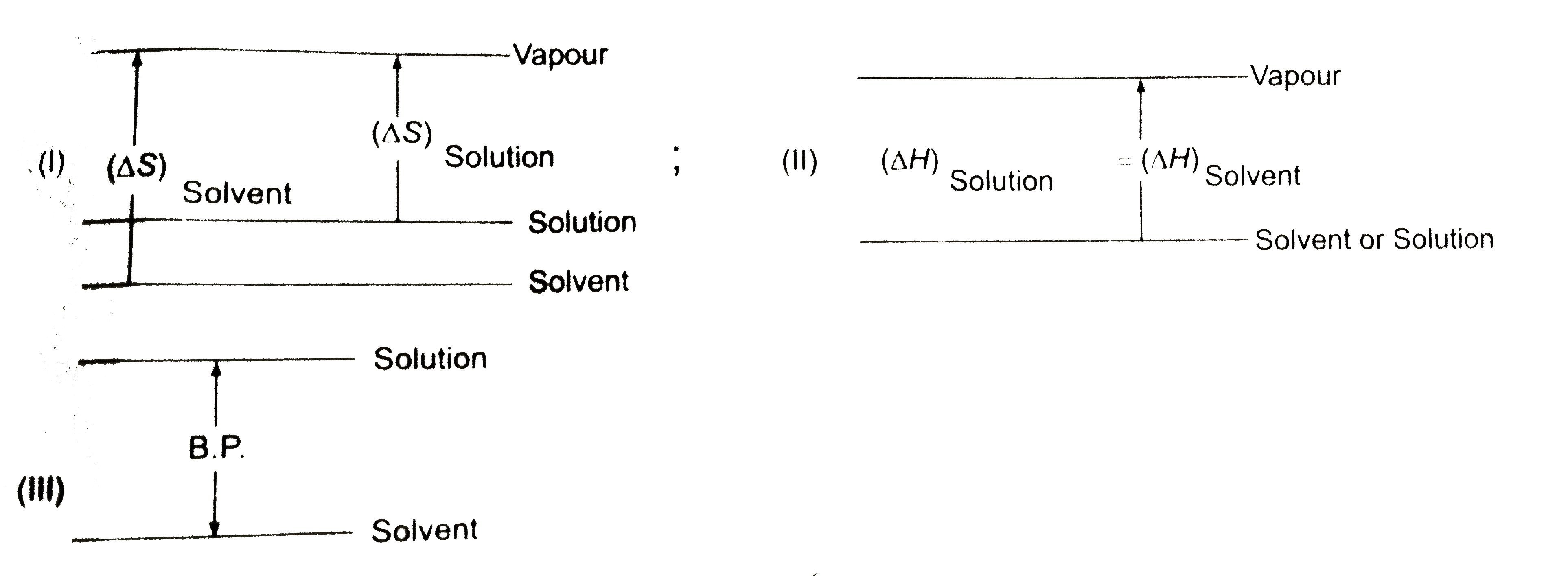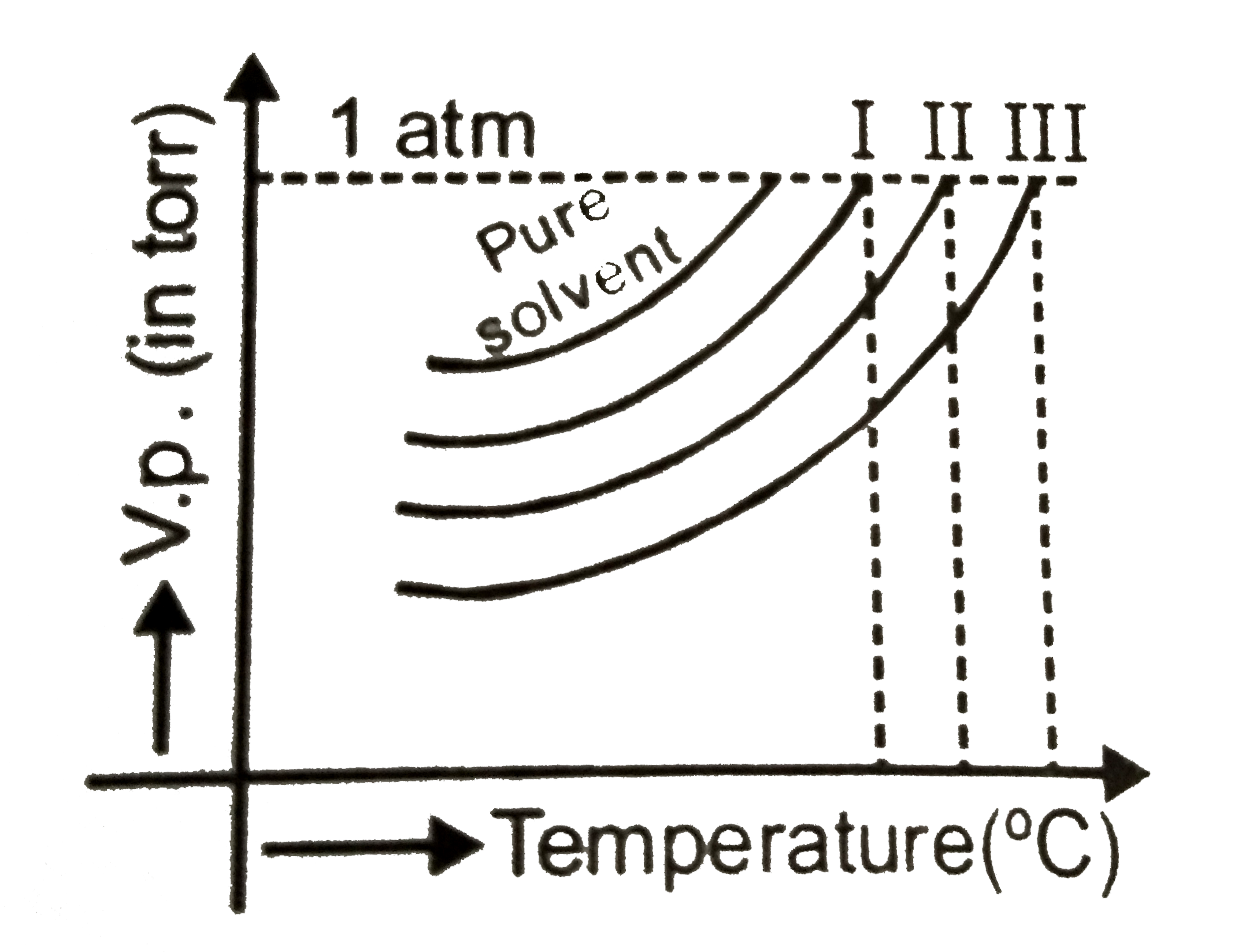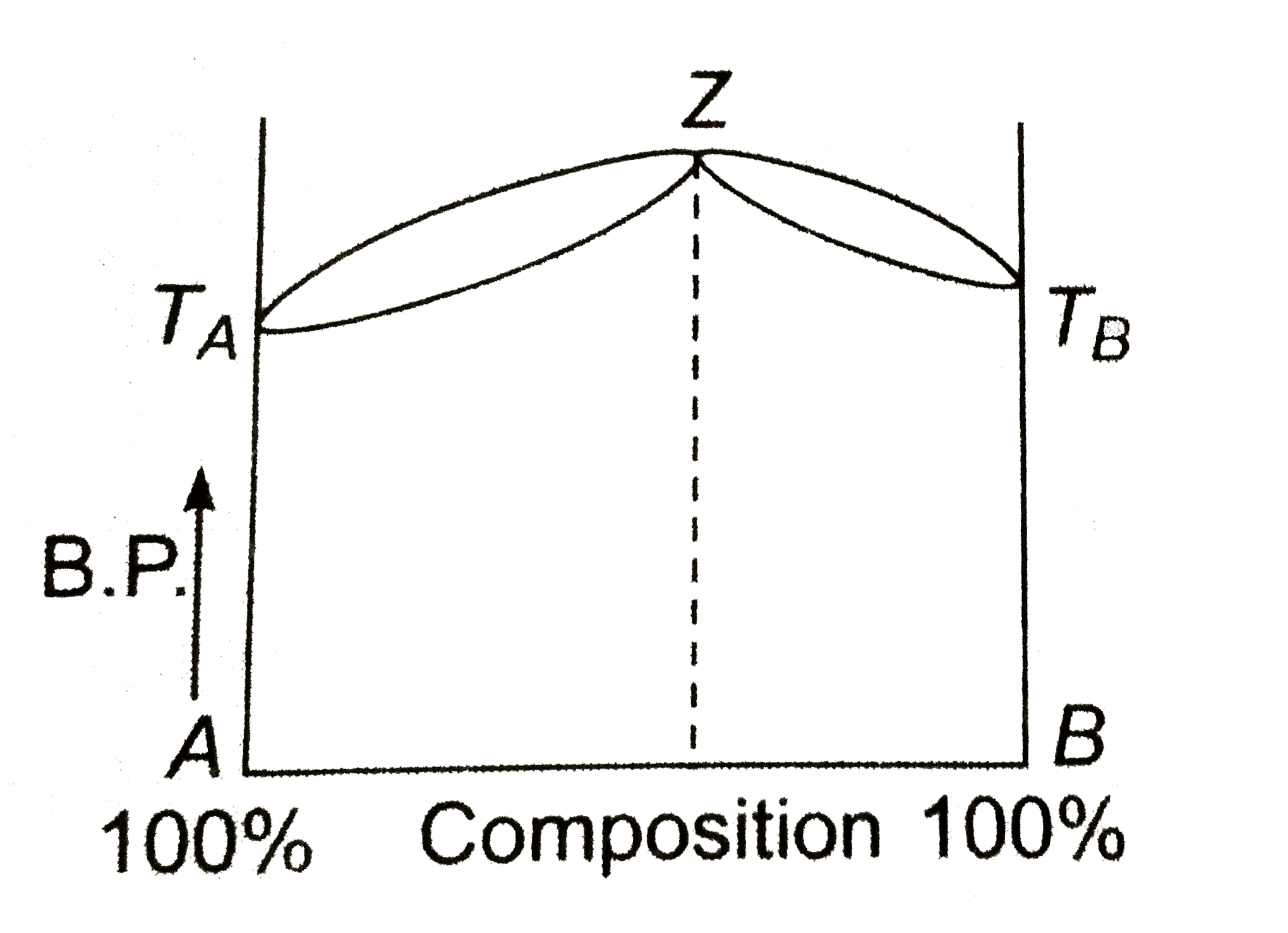Complete Solutions to leval-01 of chapter DILUTE SOLUTION of Class 11 book with complete answers and questions
| Class 11 | CHEMISTRY |
| Chapter | DILUTE SOLUTION |
| NARENDRA AWASTHI | leval-01 |
| Number Of Questions | 100 |
| Academic Year | 2023-24 |
The vapour pressure of a given liquid will decrease if :
View SolutionThe normal boiling point of water is 373 k. vapour of waterr at temperature T is 19 mm hg. If enthalpy of vapoursed is 40.67 kJ/mol, them temperature Twould be
(use : log 2 = 0.3, R : 8.3` Jk^(-1)mol^(-1)`):
View SolutionA sample of the liquid `H_(2)O` at 18.0 g is injected into an evacuated 7.6 L flask maintained at `27.0^(@)C`. If vapour pressure of `H_(2)O` at `27.0^(@)C` is 24.63 mm Hg, what weight percentage of the water will be vaporised when the system comes to equilibrium? Assume water vapors behaves as an ideal gas. The volume occupied by the liquid water is negligible compared to the volume of the container:
View SolutionRaoult's low is obeyed by each constituent of binary liquid solution when :
View SolutionFor a binary ideal liquid solution, the total vapour of the solution is given as:
View SolutionFor a ideal liquid solution with `P_A^(@)gtP_B^(@)`, which relation between` X_(A)` ((mole fraction of A in liquid phase) and `Y_(A)`(mole fraction of A in vapour phase) is correct ?
View Solution`X_(A)` and `X_(B)` are the mole fraction of A and B respectively in liquid phase `y_(A)` and `y_(B)` are the mole fraction of A and B respective in vapour phase. Find out the slope of straight line if a graph is plotted `(1)/(y_(A))` along Y-axis against `(1)/(x_(A))` along X-axis gives straight line `[p_(A)^(@)` and `p_(B)^(@)` are vapour pressure of pure components A and B].
View SolutionFor a dilute solution, Raoult's low states that :
View SolutionThe solubility of a specific non-volatile salt is 4 g in 100 g of water at `25^(@)C`. If `2.0 g, 4.0 g and 6.0 g` of the salt added of 100 g of water at `25^(@)`, in system` X, Y and Z`. The vapour pressure would be in the order:
View SolutionThe boiling point of `C_(6)H_(6) , CH_(3)OH , C_(6)H_(5)NH_(2) "and"C_(6)H_(5)NO_(2) "are" 80^(@)C, 65^(@)C, 184^(@)C "and"212^(@)C` respectively. Which will show highest vapour pressure at room temperature :
View Solution6.0 g of urea (molecular mass = 60) was dissolved in 9.9 moles of water. If the vapour pressure of pure water is `P^(@)`, the vapour pressure of solution is :
View SolutionAn ideal solution was found to have a vapour pressure of 80 torr when the mole fraction of a non-volatile solute was 0.2. What would be the vapour pressure of the pure solvent at the same temperature?
View SolutionIf the vapor pressure of a dilute aqueous solution of glucose is `750 mm` of Hg at `373 K`, then molality of solute is
View SolutionEstimste the lowering of vapour pressure due to the solute (glucose) in a 1.0 M aqueous solution at `100^(@)C`:
View SolutionCalculate the weight of non`-` volatile solute having molecular weight 40, which should be dissolvd in `57 gm` octane to reduce its vapour pressure to `80% :`
View SolutionEqual mass of a soute are dissolved in equal mass of two solvents A and B and formed very dilute solution. The relative lowering of vapour pressure for the solution B has twice the relative lowering of vapour pressure for the solution A. If `m_(A) "and" M_(B)` are the molecules mass of solventds A and B respectively, then :
View SolutionAn ideal solution has two components A is more volatile than B, i.e.`P_A^(@)gtP_B^(@)` and also` P_A^(@) gt P_("total")`. If `X_(A) andY_(A)` are mole fraction of components A in liquid and vapour phases, than :
View SolutionAt `25^(@)C`, the vapour pressure of pure liquid A (mol. Mas = 40) is 100 torr and that of pure Liquid B is 40 torr, (mol. mass = 80). The vapour pressure at `25^(@)C` of a solution containing 20 g of each A and B is :
View SolutionThe liquid A and B form ideal solutions. At 300 K, the vapour pressure of solution containing 1 mole of A and 3 mole of B is 550 mm Hg. At the same temperature, if one more mole of B is added to this solution, the vapour pressure of the solution increases by 10 mm Hg. Determine the vapour pressure of A and B in their pure states (in mm Hg).
View SolutionTwo liquid A and B have vapour pressure in the ratio ` P_A^(@) : P_B^(@)`=1.3 at a certain temperature.Assume A and B from an ideal solution and the ratio of mole fractions of A to B in the vapour phase is 4 : 3, then the mole fraction of B in the solution at the same tempreature is :
(a)`1/5`
(b)`2/3`
(c)`4/5`
(d)`1/4`
View SolutionTwo liquids A and B have `P_A^(@)" and P_B^(@)` in the ratio of 1 : 3 and the ratio of number of moles of A and B in liquid phese are 1 : 3 then mole fraction of 'A' in vapour phase in equilibrium with the solution is equal to :
View SolutionBased on the given diagram, which of the following statements regarding the homogenous solution of two volatile liquids are correct? (1) Plots AD and BC show that Raoult's law is obeyed for the solution in which B is a solvent and A is the solute and as well as for that in which A is solvent and B is solute. (2) Plot CD shows that Dalton's law of partial pressures is obeyed by the binary solution of components A and B. (3) EF + EG = EH; and AC and BD correspond to the vapour pressure of the pure solvents A and B respectively.

View SolutionWhich represents correct difference when non-volatile solute is present in an ideal solution?

(a)I, II, III
(b)I, III
(c)II, III
(d)I, II
View SolutionSelect correct statement :
a. Solution has more molecules randomness than a pure solvent. The entropy change between solution and solid is lager than the entropy change between pure solvent and solid.
b. Heat of fusion of solution are positive
c. Both a and b
d. None of these
View SolutionSelect correct statement :
View SolutionThe vapour pressure curves of the same solute in the same solvent are shown below. The curves are parallel to each other andnot intersectt. The concentrations of solutions are in order of :

View SolutionBoiling point composition diagram of the liqid-vapour equilibrium for A and B is shown in the figure. If a binary liquid mixture of A and B is distilled fractionally, which of the following would be correct observation ?

View SolutionThe boiling point of an azeotropic mixture of water and ethyl alcohol is less than that of the theoretical value of water and alcohol mixture. Hence the mixture shows
View SolutionFormation of a solution from two components can be considered as :
(i) pure solvent `rarr` separated solvent molecules, `/_\H_(1)`
(ii) Pure solute `rarr`separated molecules,`/_\H_(2)`
(iii) separated solvent and solute molecules`rarr`solution, `/_\H_(3)`
solution so formed will be ideal if :
View SolutionTotal vapour pressure of mixture of 1 mol X (`P_X^(@)` = 150 torr) and 2 mol` Y(P_Y^(@))` = 300 torr is 240torr. In this case :
View SolutionIn a mixture of A and B, components show positive deviation when:
View SolutionA liquid mixture ohaving composition corresponding to point Z in the figure shown is subjected to distillation at constant pressure. Which of the following statements is correct about the process?

View SolutionWhich will from maximum boiling azeotrope ?
View SolutionTotal vapour pressure of mixture of 1 mole of volaile components A (`P_(a^(%)`)=100 mm Hg) and 3 mole of volatile component B(`P_B^(@) =80 mm Hg`) is 90 mm Hg. For such case:
View SolutionThe azeotropic mixture of water (`B.P. = 100^(@)C`) and HCl(`B.P. =86^(@)C`)boils at about `120^(@)C`. During fractional distillation of this mixture it is possible to obtain :
View SolutionAzeotropic mixture of water and `C_(2)H_(5)OH` boils at 351 K. By distilling the mixture it is possible to obtain
View SolutionAnazeotropic mixture of two liquid has a boiling point higher than either of them when it :
View SolutionIf two liquids A (`P_A^(@) =100`torr) and (`P_B^(@)` =200 torr ) which are completely immiscible with each other (each one will behave indepenently of the othere)are present in a closed vessel, the total vapour pressure of the system will be :
View SolutionWhen a liquid that is immiscible with water was steam distilled at `95.2^(@)C` at a total pressure of 748 torr, the distilled contained 1.25 g of the liquid per gram of water . The vapour pressure of water is 648 torr at `95.2^(@)C`, what is the molar mass of liquid?
View SolutionWater and chlorobenzene are immiscible liquids. Their mixture boils at `89^(@)C` under reduced pressure of `7.7 xx10^(4) pa`. The vapour pressure of pure water at `89^(@)C` is `7 xx10^(4) pa` Mass per cent of chlorobenzene in the distillate is :
View SolutionWhich of the following is not a colligative property ?
View SolutionThe degree of an electrolyte is a and itsvan't Hoff factor is i. The number of ions obtained by complate dissocition of 1 molecules of electrolyte as :
View SolutionOne mole of a solute A is dissolved in a given volume of a solvent. The association of the solute take place as follows: `nArarrA_(n)` If `a` is the degree of association of A, then van't hoff factor `i` is expressed as:
View SolutionThe van't Hoff factor `i` for an electrolyte which undergoes dissociation in one solvent and association in other solvent respectively:
View SolutionWhich solution has the highest vapour presssure ?
View SolutionAn aqueous solution is 1.00 molalin KI. Which change will cause the vapour pressure of the solution to increase ?
View SolutionFour solutions of `K_(2)SO_(4)` with the concentrations 0.1m, 0.01m ,0.001 m, and 0.0001 m are available . The maximum value of colligative property corresponds to :
View SolutionMoles of` Na_(2)SO_(4)` to be dissoved in 12 mole water to lower its vapour pressure by 10 mm Hg at a temperature at which vapour pressure of pure water is 50 mm is:
View SolutionA very diluted saturated solution of a sparingly soluble salt `X_(3)Y_(4)` has a vapour pressure of 20 mm Hg temperature T,while pure water exerts a pressure of 20.0126 mm Hg at the same temperature . Calculate molality (m)at temperature T :
View SolutionWhen 1 mole of a solute is dissolved in 1 kg of `H_(2)O `, boiling point of solution was found to be `100.5^(@)`C. `K_(b)` for `H_(2)O` is :
View SolutionChoroform , `CHCl_(3)`, boils at `61.7^(@)`C. If the `K_(b)` for choroform is `3.63^(@)C//"molal"`, what is the boiling point of a solution of 15.0 kg of` CH_(3)` and 0.616 kg of acenaphthalene, `C_(12)H_(10)` ?
(a)61.9
(b)62
(c)52.2
(d)62.67
View SolutionA compound has the empirical formula `C_(10)H_(8)Fe`. A solution of 0.26 g of the compound in 11.2 g of benzene (`C_(6)H_(6)`)boils at `80.26^(@)C`. The boiling point of benzene is `80.10^(@)C`, the` K_(b)` is `2.53^(@)C`/molal. What is the molecules formula of the compound?
(a)`C_(30)H_(24)Fe_(3)`
(b)`C_(10)H_(8)Fe`
(c)`C_(5)H_(4)Fe`
(d)`C_(20)H_(16)Fe_(2)`
View SolutionA solution of 0.640 g of azulene in 100.0 g of benzene is `80.23^(@)C`. The boilingpoint of benzeneis `80.10^(@)C`, and` K_(b)` is `2.53^(@)C`/molal What is the molecular mass of azulene?
(a)108
(b)99
(c)125
(d)134
View SolutionOne molal solution of a carboxylic acid in benzene shows the elevation of boiling point of 1.518 K. The degree of association for simerization of the acid in benzene is (`K_(b)` for beznene = `2.53 K kg mol^(-1)` ):
(a)0.6
(b)0.7
(c)0.75
(d)0.8
View SolutionThe normal boiling point of toluene is `110.7^(@)C` and its boiling point elevation constant `3.32 " K kg mol"^(-1)`. The enthalpy of vaporization of toluene is nearly :
View SolutionWhich one of the following aqueous solutions will exhibit highest elevation in boiling point?
View SolutionCalcuate the percentage degree of dissociation of an electrolyte `XY_(2)` (Normal molar mass = 164) in water if the water if the observed molar mass by measuring elevation in boiling point is 65.6
View SolutionIf the elevation in boiling point of a solution of non-volatile, non-electrolytic and non-associating solute in solvent (`K_(b) =xK.kg"mol"^(-1)`) is yK,then the depression in freezing point of solution of same concentration would be
(`K_(f)` )of the solvent = `zK.kg"mol"^(-1)`)
View SolutionWhen a solution containing non- volatile solute freezes, which equilibrium would exist?
View SolutionBromoform has a normal has freezing point of `7.734^(@)C` and `K_(f)=14.4^(@)C// m`.a solution of 2.60 g of an unknown substance in 100 g of freezes at `5.43^(@)C`. What is the molecules mass of the unkniwn substance ?
View Solution`C_(6)H_(6)` freezes at `5.5^(@)C`. At what tempreature will a solution of 10.44 g of `C_(4)H_(10)` in 200 g of `C_(6)H_(6) "freeze" K_(f)(C_(6)H_(6))= 5.12^(@)C//m`
View SolutionHow much ethyl alcohol must be added to `1.00 L` of water so that the solution will not freeze at `-4^(@)F` ? `K_f` of water = `1.86 ^(@)C/m`
View SolutionThe freezing point of a solution of 2.40 g of biphenyl (`C_(12)H_(10)`) in 75.0 g of benzene (`C_(6)H_(6)`) is `4.40^(@)C`. The normal freezing point of benzene is `5.50^(@)C`. What is the molal freezing point constant `(@C//m)` for benzene ?
View SolutionA solution containing 1.8 g of a compound (empirical formula `CH_(2)O`) in 40 g of water is observed to freeze at `-0.465^(@)`C. The molecules formulea of the compound is (`K_(f)` of water =1.86kg K`mol^(-1)`):
View SolutionFreezing point of the following equilibrium, liquid solvent `hArr` solid solvent is :
(a)`(/_\H -/_\G)/(T/_\S)`
(b)`(/_\H)/(/_\S)`
(c)`(/_\G)/(/_\S)`
(d)`(/_\S)/(/_\H)`
View SolutionFreezing point of a solution is smaller than freezing point of a solvent. It is due to :
View SolutionWhen 36.0 g of a solute having the empirical formula `CH_(2)O` is dissovled in 1.20 kg of water, the solution freezes at `-0.93^(@)C`. What is the moleculer formula of the solute ? (`K_(f) = 1.86^(@)C kg mol^(-1)`)
View SolutionCalulate the molesules mass of a substance whose 7.0% by mass solution in water freezes at `-0.93^(@)C`. the cryosctopic constant of water is `1.86^(@)C kg mol^(-1)` :
(a)`140 g mol ^(-1)`
(b)`150.5 g mol ^(-1)`
(c)`160 g mol ^(-1)`
(d)`155 g mol ^(-1)`
View SolutionCamphor is often used in molecular mass determination because
View SolutionFor 1 molal solution of each compound minimum freezing point will be assuming compound ionisation in each case :
(a)`[Fe(H_(2)O)_(6)]Cl_(3)`
(b)`[Fe(H_(2)O)_(5)Cl]Cl_(2) . H_(2)O`
(c)`[Fe(H_(2)O)_(4)Cl_(2)]Cl .2 H_(2)O`
(d)`[Fe(H_(2)O)_(3)Cl_(3)] .3 H_(2)O`
View SolutionWhich of the following solutions `(1 molal)` will have the maximum freezing point, assuming equal ionization in each case?
View Solution`PtCl_(4).6H_(2)O`can exist as hydrated complex `1` molal aq.solution has depression in freezing point of `3.72^(@)C`Assume `100%` ionisation and `K_(f)(H_(2)O=1.86^(@)Cmol^(-1)Kg)` then complex is
View SolutionA complex is represented as `CoCl_(3) . XNH_(3)`. Its `0.1` molal solution in aqueous solution shows `Delta T_(f) = 0.558^(circ). (K_(f)` for `H_(2)O` is `1.86 K "molality"^(-1))` Assuming `100%` ionisation of complex and co-ordination number of `Co` as six, calculate formula of complex.
View SolutionThe freezing point of equimolal solution will be highest for :
View SolutionThe freezing point of 4% aqueous solution of 'A' is equal to the freezing point 10% aqueous solution of 'B'. If the molecular mass of 'A' is 60, then the molecular mass of 'B' will be:
View SolutionThe depression in freezing point of `0.01 m` aqueous `CH_(3)COOH` solution is `0.02046^(@)`, `1 m` urea solution freezes at `-1.86^(@)C`. Assuming molality equal to molarity, `pH` of `CH_(3)COOH` solution is
a. 2
b. 3
c. 4
d. 5
View SolutionWhen mercuric iodide is added to the aqueous solution of potassium iodide, then:
View SolutionDimer of acetic acid in liquid benzene is in equilibrium with acetic acid monomer at certain temperature and pressure. If 25% of the dimer molecules are separated out then
(a)freezing point of the solution reduces
(b)average molar mass of solute increases
(c)boiling point of solution increases
(d)molar mass of solute decreases
View SolutionThe temperature of a city was found to be `-9.3^(@)`C. A car used, whose radiator was filled with 5 L of water . What minimum quantity of antifreezing agent ethylene glycol were added to water of radiator in order to use the car for teavelling? (`K_(f)`of water 1.861.86 k `mol^(-1))`
View SolutionThe cryoscopic contant of water is 1.86 K kg `mol^(-1)`. A 0.01 molal acetic acid solution produces a depression of `0.0194^(@)C` in the freezing point. The degree of dissociation of acetic acid is :
View SolutionIf 1m solution of benzoic acid in benzene has a freezing point depression of `3.84 ^(@)C` . `(K_(f)=5.12^(@)C mol^(-1)`kg) and boiling point elevation of `2.53^(@)C(K_(b)` =`2.53^(@)C "mol"^(-1) kg)`, then select the correct statement/s :lt brgtstatement I : there are dimar formation when under =going freezing
Statement II : there are no change when undergoing boiling
Statement III : reverse of I and II ltbr. Statement IV : dimer formation in freezing and boiling state
View SolutionIn a 0.5 molal solution KCl, KCl is 50% dissociated. The freezing point of solution will be (`K_(f)` = 1.86 K kg `mol^(-1)`):
View SolutionA 1.0 g sample of `Co``(NH_(2)CH_(2)CH_(2)NH_(2))_(3)Cl_(3)` is dissolved in 25.0 g of water and the freezing point of the solution is `-0.87^(@)C`. How many ions are produced per mole of compound? The `K_(f)` of water is `1.86^(@)C//"molal"`
View SolutionAn aqueous solution contain 3% and 1.8% by mass urea and glucose respectively. What is the freezing point of solution ? (`K_(f)=1.86^(@)C//m`)
View Solutionphenol associates in benzene to a certain extent in dimerisation reaction. A solution containing 0.02 kg of phenol in 1.0 kg of benzene has its freezing point depressed 0.69 k. [`K_(f)(C_(6)H_(6)) =5.12 k kg"mol"^(-1)`]. The degree of association:
View SolutionAssuming complete ionisation, the solution having maximum freezing point will be:
View SolutionIn a 2.0 molal aqueus solution of a weak acid HX the degree of disssociation is 0.25. The freezing point of the solution will be nearest to: (`K_(f)=1.86 K kg "mol"^(-1)`)
View SolutionAn aqueous solution of 0.01 m KCl cause the same elevation in boiling point as an aqueous solution of urea. The concentration of urea solution is :
View Solutionwhen some NaCl was dissolved in water, the freezing point depression was nmerically equal to twice the molal f.p. depression constant. The relative lowering of vapour pressure of the solution in nearly :
View SolutionWhich one of the following statement is false ?
View Solution0.1 molal aqueous solution of an electrolyte `AB_(3)` is 90% ionised. The boiling point of the solution at 1 atm is (`K_(b(H_(2)O)) = 0.52 kg " mol"^(-1)`)
View SolutionWhich of the following aqueous solutions has osmotic pressure nearest to pure solvent ?
View Solution0.1 M NaCl and 0.05 M `BaCl_(2)` solutions are separated by a semi-permeable membrane in a container. For this system, choose the correct answer
View SolutionTwo aqueous solutions, A and B, are separated by a semi- permeable membrane. The osmotic pressure of solution A immediately begins to decrease. Which of the following statement is true ?
View SolutionWhich one of the following pairs of solution can we expect to be isotonic at the same temperature
View SolutionThe empirical formula of a non-electrolyte is `CH_(2)O`. A solution containing 3 g `L^(-1)` of the compound exerts the same osmotic pressure as that of 0.05 M glucose solution. The molecules formula of the compound is :
View SolutionA semipermeable membrane used in the measurement of osmotic pressure of a solution allows the passage of
View SolutionIn the case of osmosis, solvent molecules move from :
View SolutionThe osmotic pressures of equimolar solutions of urea , `BaCl_(2) and AlCl_(3)`will be in the order :
View SolutionAssuming each salt to be `90%` dissociated which of the following will have the highest osmotic pressure?
View Solution
leval-01 questions and complete solutions for chapter DILUTE SOLUTION of NARENDER AVASTHI CHEMISTRY (ENGLISH) of Class 11